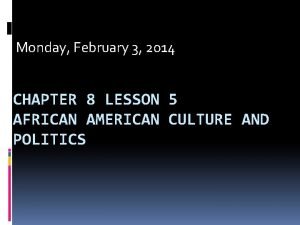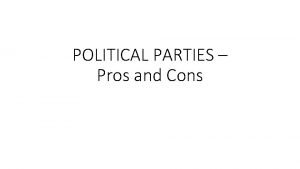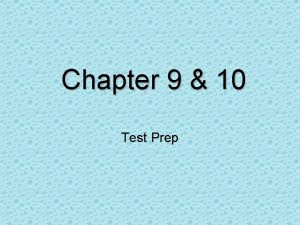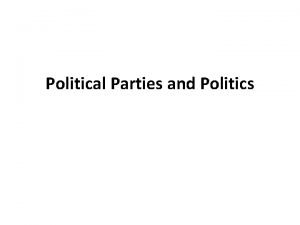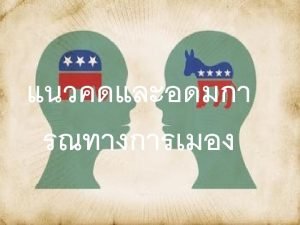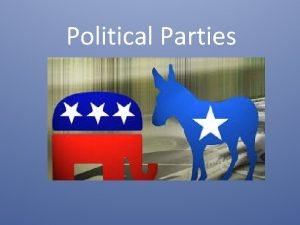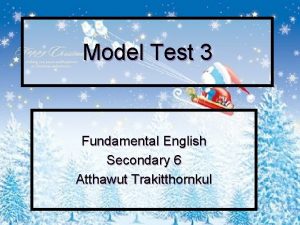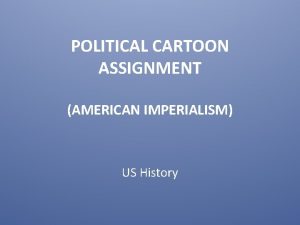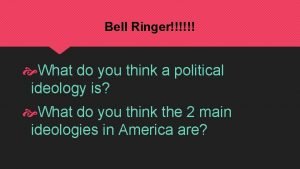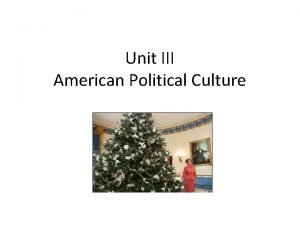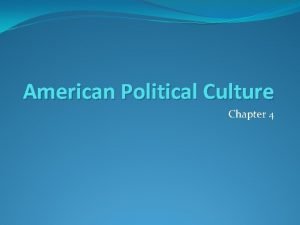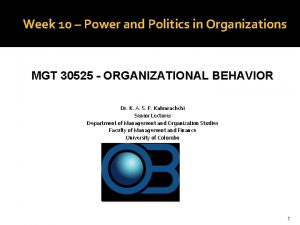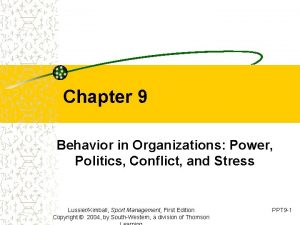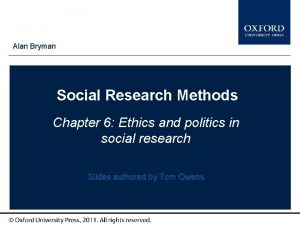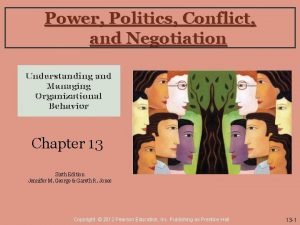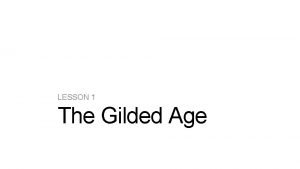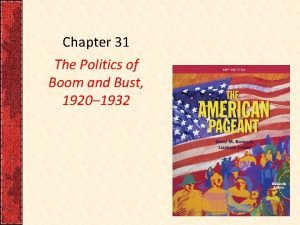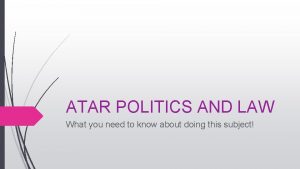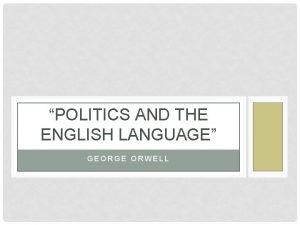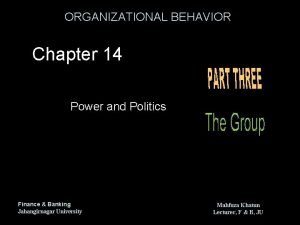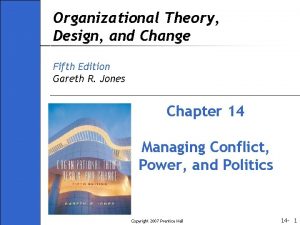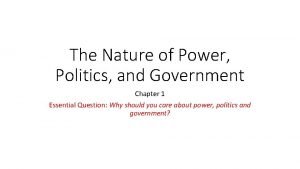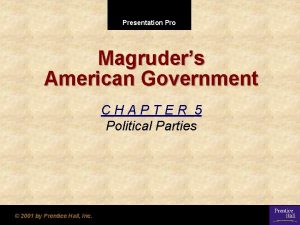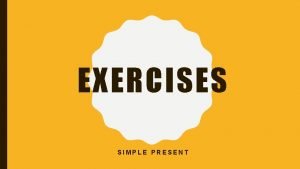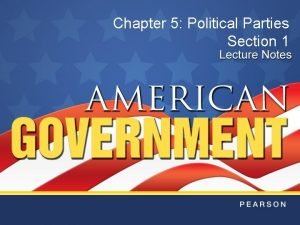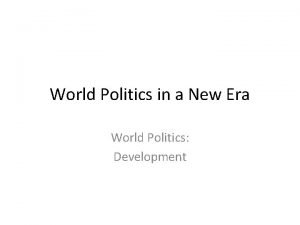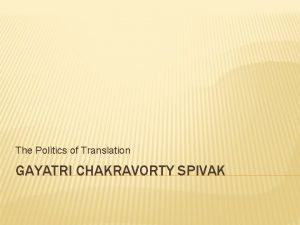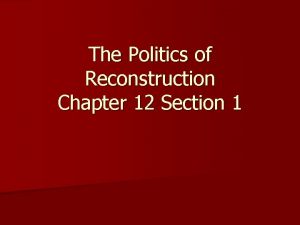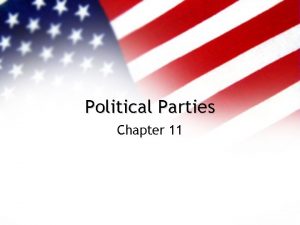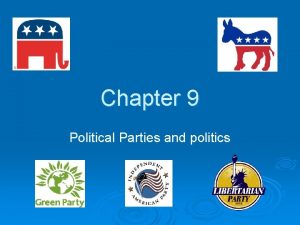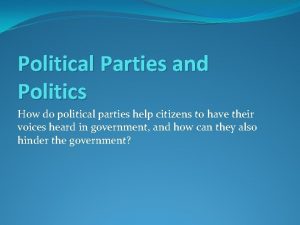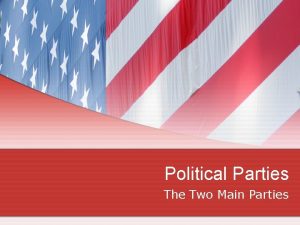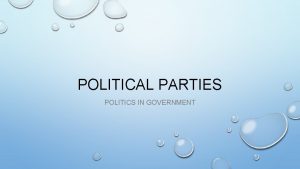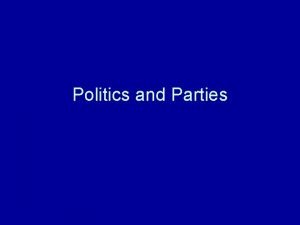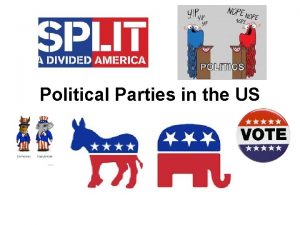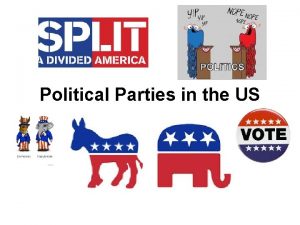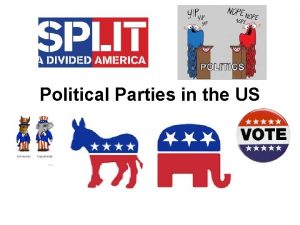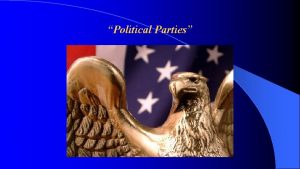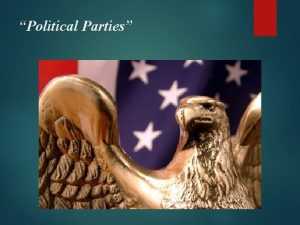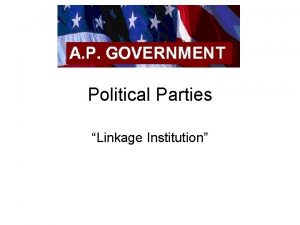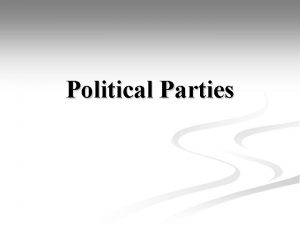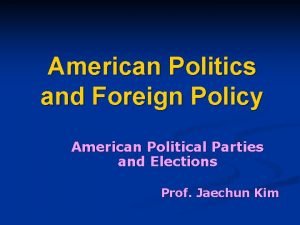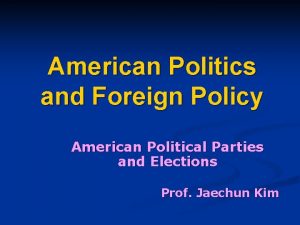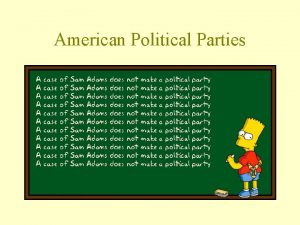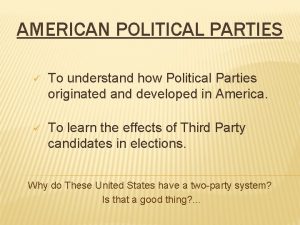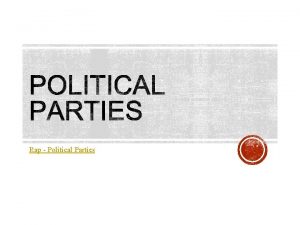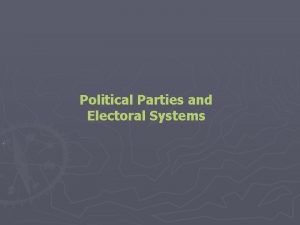Political Parties in American Politics Political Parties and









































- Slides: 41

Political Parties in American Politics

Political Parties and Democracy • Political Parties – Defined – Party Platform – Functions • Formation – Policymaking – Elections

Political Parties and Democracy • What is a Political Party? – An organization that seeks to influence government policy by electing its members to office to implement the party platform • Parties compared to interest groups call themselves a party – – – Republican Party Democratic Party Green Party Reform Party Libertarian Party • James Carville “purpose of a political party in a democracy is to win elections”

Political Parties and Democracy • Party Platform – Position paper drafted by party activists at the national convention – Planks represent issues – Defines what the party would do if it controlled the government • Presidential candidates are not bound by the platform and may have to run to the center and away from the platform

Political Parties and Democracy • Party Functions – Nominate Candidates – Structure Voting Choice – Propose Alternative Programs – Coordinate Government Actions – Link Between Groups and Individuals and Government Officials

Political Parties and Democracy • Why Do Parties Form – Parties form as outgrowths of policy debate and policymaking process – Parties form as a necessary element of elections • Democratic theorists believe parties are necessary for democracy to exist – Must have at least two competing parties – In Southern States, only one party but liberal versus conservative factions within the party • In the 1980 s conservative Democrats became Republicans • Liberal Democrats remained in the party, but the South turned increasingly read

Political Parties and Democracy • Internal Mobilization – Party formed by government officials inside the government – i. e. , Federalist Party • External Mobilization – Party formed outside government to gain control of political institutions • Jeffersonian Republicans or Democratic Republicans • Republican Party • National Socialist Party (NAZI Party)

Dominant Themes • Realignment • De-alignment • Two-Party System

Dominant Themes • Realignment – Dominate party replace by new dominant party – Critical election occurs every 28 to 36 years • • • 1800 1828 1860 1896 1932 – Since 1968 political process characterized by “divided government” • Presidency is controlled by one party and Congress under the control of the other party

Dominant Themes • Causes of Realignment – Conversion Theory • Shift in voter support from one party to a new party • Caused by cleavage issue or wedge issue – Slavery in the 1850 s – Depression in 1890 s – Depression in the 1930 s – Mobilization Theory • New voters mobilized to vote in critical election • If 2008 is a realignment – Voters converted – Voters mobilized

Dominant Themes • De-alignment – 1960 s voters shifted away from identifying with two major parties – Labeled themselves as Independents – Democratic theorists feared “death” of democracy • Resurgence of Partisanship – 1980 Election of Reagan – 1994 Republican Revolution – 2000 Election of G W Bush • Independent Voters – Split 50 -50 or proportion of candidate vote – Mc. Cain hoped these voters would shift to him on election day

Dominant Themes • Two-Party System – US considered two-party system despite presence of “third-parties” – US parties are catch-all/umbrella parties • Less ideological than European parties • Attempt to capture political center to win the election – Minor parties or “third-parties” form as protests • • Free Soil Know-Nothings Prohibition Populist States Rights/Dixiecrats American Independent Reform Green

Dominant Themes • Major parties co-opt, borrow, or swipe the ideas of successful minor parties – Teddy Roosevelt – Franklin D. Roosevelt – Republicans and Democrats in 1990 s

Dominant Themes • Why a Two-Party System? – Electoral System • Single-Member District • Plurality/Winner Take All – Sociological/Psychological Opposition • Communists and Socialists

Historical Overview • Pre-Party, 1787 -1789 – Constitution makes no provision for parties – Winner of electoral college becomes president and second place becomes VP – Early political factions • Federalists • Anti-Federalists

George Washington, 1789 -1796 • Unanimously elected • Administration “bipartisan” – Federalists • John Adams • Alexander Hamilton – Anti-Federalists • Thomas Jefferson • Infighting between Hamilton and Jefferson over agenda led to development of parties – Federalist Party – Jeffersonian Republicans or Democratic Republicans

Partisanship and the Election of 1796 • First Partisan Election – John Adams nominated by Federalists – Thomas Jefferson nominated by Democratic-Republicans • Adams wins electoral college and Jefferson becomes VP • Alien and Sedition Acts made it illegal to defame the president or Congress – Democratic-Republicans convicted for writing essays critical of Adams – Supreme Court refused to hear cases – Law expired in 1801 • Democratic-Republicans begin mobilizing to defeat Federalists

Election of 1800 • Parties select tickets – Federalists • John Adams • Charles Pickney – Democratic Republicans • Thomas Jefferson • Aaron Burr • Jefferson and Burr tie • Election to the House – One State One Vote – Seven Days 36 Ballots – Jefferson wins, but questions actions of Burr • 12 th Amendment (1804) provides that electors will cast separate ballot for president and VP

Demise of the Federalists • 1800 to 1820 witnessed the disappearance of the Federalist Party – – – Jefferson 1800 Jefferson 1804 Madison 1808 Madison 1812 Monroe 1816 Monroe 1820 • Era of Good Feelings in 1820 with no party opposition – Monroe should have been elected unanimously – Electoral vote thrown to J Q Adams to preserve Washington’s place in history

Birth of the Democrats • 1824 – Four candidates for Democratic Republicans • • J Q Adams A Jackson H Clay Wm Crawford – Jackson wins plurality of electoral college and popular vote, but not the required majority of the electoral college – Election thrown once again to the US House • J Q Adams declared winner • Jackson faction claims corrupt bargain and bolt from the party

The Democratic Party • Democratic Party born out of 1824 election controversy – Martin Van Buren aligns North and South Democrats behind Andrew Jackson – Mobilization of voters • Jackson wins election of J Q Adams – Jackson broadly wielded power drawing opposition to his “reign” – National Republicans unable to maintain opposition • Whig Party forms in opposition and has moderate success between 1836 and 1952

The Stress of Slavery • Slavery cleavage issue weakening Democrats and destroying Whigs – – – Missouri Compromise of 1820 Compromise of 1850 Kansas Nebraska Act of 1854 Dred Scott Decision John Brown Revolt

Republican Party • Anti-slavery Whigs and Democrats realize incapacity or unwillingness of party officials to deal with slavery • Republican Party formed in 1854 as anti-slavery party – Nominate Fremont in 1856 – Win control of House in 1858 – Lincoln is nominee in 1860

Reconstruction and the South • A Johnson becomes president following assassination of Lincoln – Impeached by House for violating the Tenure Act – Senate fails to convict • Republican post-war agenda and Reconstruction fuel Southern opposition and establishes the “Solid South” that votes for Democratic candidates at national and state levels – Exception 1928 when Democrats nominate Catholic Al Smith – Exception 1952 when Republicans nominate Dwight D Eisenhower • Republican Party is all but nonexistent in South until Reagan

Republicans Dominate Presidential Elections, 1868 -1896 • Republican Presidents – U S Grant 1868, 1872 – Rutherford Hayes 1876 – James Garfield 1880 • Assassinated – Chester Arthur 1881 – Benjamin Harrison 1888 • Democrat Presidents – Grover Cleveland 1884 – Grover Cleveland 1892

Depression and the Realignment of 1896 • • Democrat Cleveland president during Depression of 1890 Economy used as wedge issue to bring about realignment in 1896 – Mc. Kinley versus Bryan – Wizard of Oz • Republicans dominate in White House and congressional races between 1896 and 1932 – Mc. Kinley • Assassinated – – – • T Roosevelt Wm Taft Harding Coolidge Hoover Democrats limited to two terms – Woodrow Wilson 1912 – Woodrow Wilson 1916

The Great Depression and a Democratic Realignment of 1932 • Hoover president at beginning of Great Depression – 1932 Unemployment 25% – Homerville and Hoover Flags • F D Roosevelt is the change candidate in 1932 – New Deal Program • Economy cleavage issue brings about realignment in 1932 with the New Deal Coalition – Roosevelt 1932, 1936, 1940 and 1944 • Depression, Dust Bowl • World War II

Post-FDR Democratic Dominance • Democrat Presidents – Truman 1948 -1952 • “Dewey Wins” • Constitution amended to limit president to two terms – J F Kennedy 1960 • Assassinated Nov 1963 • Republican President – Dwight D Eisenhower 1952, 1956 – VP Richard Nixon – “I Like Ike”

1964 and LBJ • Johnson v Goldwater – Daisy Girl Ad – Landslide • Johnson as President – Civil Rights Act of 1964 – Voting Rights Act of 1965 – Vietnam War

1968: LB, War, and Civil Rights • Johnson runs for reelection, but withdraws after weak showing versus peace candidate Mc. Carthy in NH – Civil Rights – Vietnam War • Hubert Humphrey becomes LBJ’s surrogate • R F Kennedy declares – MLK assassinated – Bobby assassinated in California

1968 and Chicago • Democratic National Convention in Chicago – Mayor Daley – Anti-War Delegates – Anti-War Movement • Abbie Hoffman • Tom Hayden • Allen Ginsberg • Protests/Demonstrations

1972: Watergate • Watergate Scandal – Republican operatives arrested in DNC – Cover-Up Begins • • • Hush Money CIA operation Secret Tapes Expletive Deleted Transcripts Saturday Night Massacre – Nixon resigns in disgrace • Gerald Ford – Only person to serve as president never elected to serve as VP or President – Gerald Ford pardons Nixon – Republican image is destroyed

1976: Jimmy Carter • Gerald Ford runs in 1976, but is defeated by Jimmy Carter • Carter’s position as an outsider diminishes his ability to work with Congress

1980: Ronald Reagan • Reagan “rebrands” the Republican Party – Reagan in 1980 • Misery Index • “Are You Better Off Now Than Four Years Ago” – Reagan in 1984 • Democrats nominate Walter Mondale and Geraldine Ferraro (a woman as VP) • Age Becomes Issue – Bush in 1988 • Democrats nominate Dukakis • Bush VP Quayle

1992: Wm Jefferson Clinton • Clinton returns Democratic Party back to the political center • Republican Revolution in 1994 gives party control of House and Senate • Clinton wins reelection in 1996, but is mired in Lewinsky scandal

2000: George W. Bush • Bush defeats Gore in close election mired by confusion over Florida ballots – Recount – Chads • Bush defeats Kerry in 2004 • Democrats regain control of Congress in 2006

2008: Barack Obama • Obama redefines electoral map and defeats Mc. Cain • Pundits declare realignment

Party Organization • National Convention – Nominate candidate – Write platform • National Committees – House and Senate – Functions • • Raise money Head off factional disputes Enhance media image Mobilize voters • State Party – Statewide – County – Precinct

Parties and the Electorate • Party Id – Party made up of “rank and file” members – Party affiliation is psychological and related to ideology

Parties and the Electorate • Democrats – Education • HS or Post-Grad – Occupation/Income • Union, Unskilled, Low – Gender, Race, Relationship • • Women Blacks Hispanics Unmarried/Gays – Religion • Catholics and Jews – Society • Punk, Rock and Hip Hop – Region/Residency • Northeast • Upper Midwest • West (CA, OR, WA)

Parties and the Electorate • Republicans – Education • College – Occupation/Income • Professional, White Collar • High Income – Gender, Race, Relationship • • Whites Men (NASCAR) Cuban Americans Married – Religion • Southern Baptists/Evangelicals – Society • Country Music – Region/Residency • South, Southwest, Near West • Suburbanites • Rural Areas
 Chapter 8 lesson 5 african american culture and politics
Chapter 8 lesson 5 african american culture and politics Political parties pros and cons
Political parties pros and cons Win the white house brainpop
Win the white house brainpop What was one way progressives differed from populists
What was one way progressives differed from populists Political parties
Political parties The supreme court change
The supreme court change A political party is an association of
A political party is an association of Sistemas democraticos
Sistemas democraticos Political parties
Political parties Interactions between ais and internal and external parties
Interactions between ais and internal and external parties If a ruby is heated it temporarily lose its color
If a ruby is heated it temporarily lose its color American imperialism political cartoons explained
American imperialism political cartoons explained How has the us changed from 1798 to 1898
How has the us changed from 1798 to 1898 American political spectrum
American political spectrum American political culture definition
American political culture definition American political culture definition
American political culture definition Power and politics in organizations
Power and politics in organizations Informational opportunities challenges
Informational opportunities challenges Bureaucracy and politics in india
Bureaucracy and politics in india Power, politics and conflict in organizations
Power, politics and conflict in organizations Ethics and politics in social research bryman
Ethics and politics in social research bryman Power, politics and conflict in organizations
Power, politics and conflict in organizations Philosophy, politics and economics michael munger
Philosophy, politics and economics michael munger Lesson 1 - politics and the gilded age
Lesson 1 - politics and the gilded age Chapter 31 the politics of boom and bust
Chapter 31 the politics of boom and bust Chapter 20 whose government
Chapter 20 whose government Polis bsc
Polis bsc Government unit 1 study guide
Government unit 1 study guide Politics and law atar
Politics and law atar Relationship between sports and politics
Relationship between sports and politics Politics and the english language
Politics and the english language Illegitimate political behavior
Illegitimate political behavior Power and politics organization theory
Power and politics organization theory Power and politics
Power and politics The nature of power politics and government
The nature of power politics and government Chapter 5 section 1 parties and what they do
Chapter 5 section 1 parties and what they do Iso 14001 risk and opportunities examples
Iso 14001 risk and opportunities examples Sarah and pam often go to parties
Sarah and pam often go to parties Chapter 5 section 1 parties and what they do
Chapter 5 section 1 parties and what they do World politics in a new era
World politics in a new era Spivak translation theory
Spivak translation theory The politics of reconstruction chapter 12 section 1
The politics of reconstruction chapter 12 section 1
